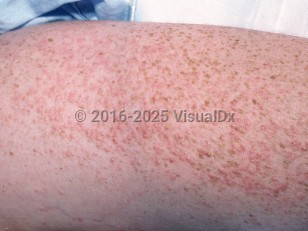Miliaria is often related to conditions of high fever or high ambient temperatures with resulting hyperhidrosis, and it is more prevalent in hot, humid conditions and tropical climates. It is a common phenomenon postoperatively and in bedridden and febrile patients. Tight clothing and transdermal drug patches have also been associated with miliaria due to occlusion of the skin. Additionally, medications that induce sweating, such as the cholinergic drugs neostigmine and bethanechol, have been linked to the development of miliaria. A few cases of miliaria occurring in patients treated with isotretinoin have been reported.
There are different types of miliaria, each classified by the depth of occlusion of the eccrine duct:
- Miliaria crystallina results from superficial obstruction of the eccrine duct within the stratum corneum. It presents as superficial vesicles with no surrounding erythema.
- Miliaria rubra is caused by obstruction of the eccrine duct within the epidermis. It is the most prevalent form of miliaria and is characterized by 2-4 mm erythematous and uniform papules or papulovesicles with background erythema.
- Miliaria pustulosa is a variant of miliaria rubra that occurs when pustules form and may indicate superimposed infection.
- Miliaria profunda results from deeper obstruction of the sweat duct at the dermal-epidermal junction. It presents as skin-colored papules with possible associated hypohidrosis or anhidrosis.



 Patient Information for
Patient Information for 
